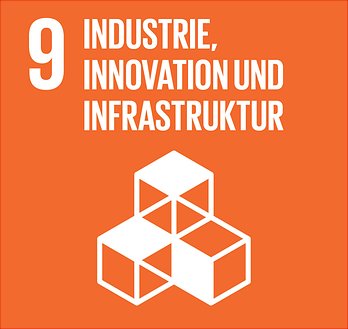SDG 9: Industry, Innovation and Infrastructure
SDG 9 calls on us to build resilient infrastructure, promote inclusive and sustainable industrialization, and foster innovation. Investments in infrastructure and innovation are key drivers of economic growth and development. Environmentally efficient measures can help to sustainably and beneficially improve the human living and working world. This includes the expansion of transport routes as well as of energy generation and the Internet because access to information and knowledge is essential for furthering innovation and entrepreneurship.

Sponsorship team
Prof. Dr. Eva Bittner
Faculty: Mathematics, Informatics and Natural Sciences
Department(s): Informatics
Profile: Prof. Dr. Eva Bittner
What are your research areas? What research projects are you currently working on? How do these relate to “your” SDG?
Information systems, in particular socio-technical system design, digital transformation, innovation management, collaboration engineering, citizen co-creation, digital participation, human/machine collaboration, human-centered information systems design, the Civitas Digitalis research project on digital and crowd-based service systems for establishing sustainable and livable living environments
Connection to SDG 9 (Industry, Innovation and Infrastructure):
Digital technologies and modern information systems offer ample potential to achieve sustainable benefits in human living and working worlds, and to shape them in a socially desirable manner. However, the inseparably linked social and technical systems must be taken into account in their design at an early stage. We conduct design-oriented research to solve social and economic challenges and promote human-centered usage of technological innovations such as interactive collaboration tools or intelligent assistance systems in production and service systems.
In the Civitas Digitalis project, we use suitable technological tools to involve inhabitants—as the experts on their own living world—in the development of innovations for the city of the future. By means of digital participation, we are increasing transparency and participation opportunities for a larger section of society and are doing our part to facilitate human-centered, sustainable, urban innovation.
How and why did you become interested in this topic?
In an age of digital technologies, industrial and public innovation requires an integrated design for social and technical systems and systematic shaping of cooperation. Together with public administration and corporate partners, we are continually identifying new design and improvement needs for the rapidly changing urban living and working worlds.
What activities are you planning as part of the SDG sponsorship? What possibilities do you see in (interdisciplinary) networking with other members of your sponsorship team?
An interdisciplinary exchange of thoughts and ideas on interfaces and cooperation possibilities in the field of urban and innovation development.
Is your topic related to any of the 16 other SDGs?
- SDG 8 (Decent Work and Economic Growth)
- SDG 11 (Sustainable Cities and Communities)
Prof. Dr. Sebastian Späth
Faculty: Business, Economics and Social Sciences
Department(s): Socioeconomics, Business Administration
Profile: Prof. Dr. Sebastian Späth
What are your research areas? What research projects are you currently working on? How do these relate to “your” SDG?
Alternative financing (crowdfunding), open innovation / open source, collaborative business models, open foresight, ecosystems, and digital platforms.
How and why did you become interested in this topic?
Community research in the open source area, expanded to open innovation and organizational collaboration. An interest in open data.
Is your topic related to any of the 16 other SDGs?
- SDG 17 (Partnerships for the Goals)
Possibly also to
- SDG 11 (Sustainable Cities and Communities)
- SDG 12 (Responsible Consumption and Production)
Prof. Dr. Stefan Voß
Faculty: Business Administration
Department(s): Information Systems
Profile: Prof. Dr. Stefan Voß
What are your research areas? What research projects are you currently working on? How do these relate to “your” SDG?
Information systems, operations research, maritime shipping, logistics, supply chain management, telecommunications, public transport, information management, metaheuristics and matheuristics, digital transformation, and digital innovation.
Connection to SDG 9 (Industry, Innovation and Infrastructure)—sustainability in ports: In the Secretary-General’s report, “Progress towards the Sustainable Development Goals” (E/2017/66), we read: “Efficient transportation services generate employment and wealth and drive economic development. [ … ] Manufacturing is a principal driver of economic development, employment and social stability.” This implies that special consideration must be devoted to the sustainable development of supply chain nodes, possibly allowing transshipment between different modes of transportation. Ports are at the forefront of these intermodal connections. To address the social and economic dimensions, we are using all means of improvement—from digital transformation to cold ironing, from reducing noise pollution as part of the environmental dimension of sustainability to sustainable working conditions for workers at and on container terminals. Needless to say, this is especially important for the wealth and sustainable development of the city of Hamburg.
How and why did you become interested in this topic?
We have a close connection to and collaborate with various companies in the above-mentioned areas, including maritime shipping.
What activities are you planning as part of the SDG sponsorship? What possibilities do you see in (interdisciplinary) networking with other members of your sponsorship team?
We are using different means (e.g., mathematical programming, digital transformation, concepts of information management) to solve maritime shipping problems. This includes various aspects of sustainability and encourages establishment of connections with various disciplines. An example: while truck drivers in the port and local area can enhance their activities with better connectivity and collaboration, we still see a gap between different topics (e.g., a current lack of truck drivers, planning enables better use of the precious time of the existing drivers). Autonomous vehicles are a future scenario, but we need to bridge the gap until they become an everyday reality by incorporating in different means of sustainability (reducing empty runs with related environmental improvements, social aspects if the truck driver profession changes, etc.).
